This was published 5 years ago
WWI Western Front, Australian Battlefields tour: Why the Great War still packs an emotional punch
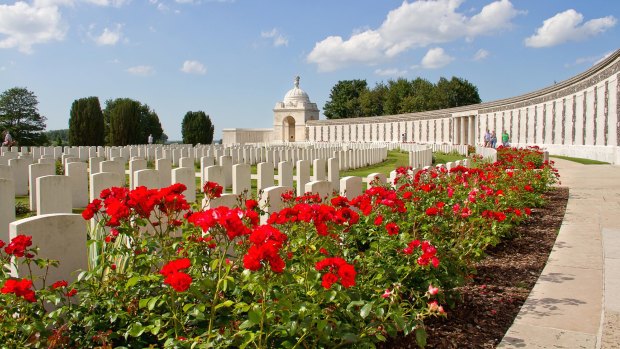
Tyne Cot, resting place of 11,900 servicemen of the British Empire from the First World War, is the largest Commonwealth Cemetery in the world.Credit: Shutterstock
We seem to have entered a dystopian domain. Up on the Somme ridge outside the village of Villers-Brettonneux, winter approaches and clouds bring November rain as a parallel story unfolds.
The narrative recited on this green and peaceful hill chronicles an unspeakable time. The Armistice centenary service at the Australian National Memorial is simple and beautiful, yet there is no beauty in words describing an abomination that made barbarians of men.
The Great War's total military and civilian casualties measured some 37 million. We enter this world through the digital recollections of ex-servicemen and women, through the battles engraved on the memorial, through music, speeches, hymns, through the Last Post and reveille played into the wind from the memorial's bullet-pocked tower overlooking the Somme Valley.
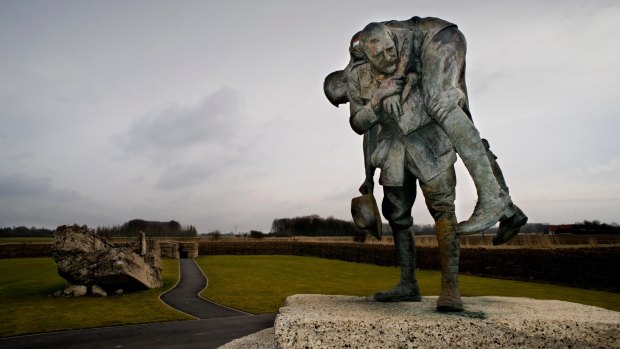
The Australian Memorial Park at Fromelles, Northern France, where the Australian forces lost many men in July 1916 attacking Aubers Ridge. Credit: Alamy
"It was all over, 11am, but so much was gone from our life," recalls a veteran. We remember because it is our history. But how we do this, with a powerful sense of avoidance, must surely define our national identity.
The Villers-Brettonneux ridge-top service on ground sown with misery is a significant fragment of our 11-day special Remembrance Day tour of the Western Front's Australian battlefields. We take this tour to commemorate, along with the millions of others who died, the 61,000 Australians killed and 156,000 wounded during the war (45,000 on the Western Front, 17,000 with no known grave) in Australia's costliest conflict.
It allows us to witness what happened along the 700-kilometre frontline of trenches, dugouts and barbed wire fencing stretching from the Swiss border to the North Sea. From Paris to Ypres to Bruges to Amiens to Paris, we trace a route through France and Belgium, confronting places whose familiar names conjure desolation.
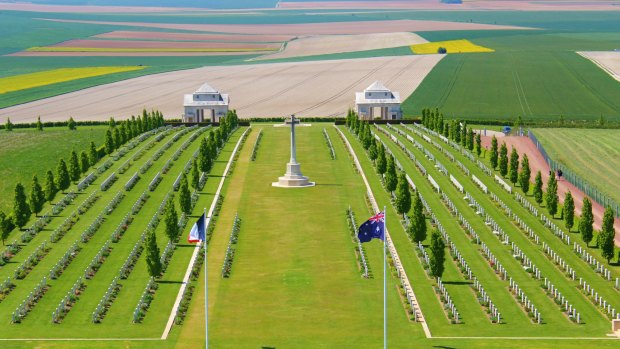
The Australian cemetery of the first world war at Villers Bretonneux in Somme, France.Credit: Shutterstock
The Somme and Flanders, Fromelles and Pheasant Wood, Passchendaele, Pozieres, Hill 60, Polygon Wood, Broodseinde, Messines, Menin Road, Hellfire Corner, Bullecourt, Le Hamel, the Ypres Salient, Mont Saint-Quentin, Peronne, Arras, VC Corner, Tyne Cot, and more.
This pilgrimage 100 years later is nothing new. Some may call it "battlefields tourism" and it is, troubling as well as cathartic, a journey towards understanding.
Ever since the war ended, veterans and their families have returned. First the spouses and parents came, seeking their missing. Then came the ex-servicemen, many physically or psychologically damaged, then their children, grandchildren and extended families, on and on until today.
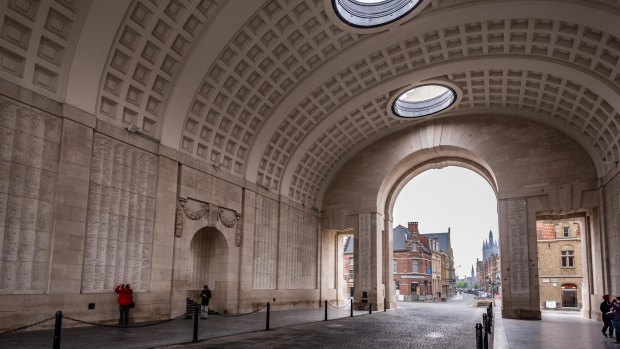
The Menin Gate memorial to the dead of World War I, Ypres, Belgium.Credit: Shutterstock
Such a sombre journey required the trappings of tourism – accommodation, restaurants and guidebooks. A Michelin guide to the battlefields first appeared in 1919 and by November 11, 1918, Thomas Cook and Son were making arrangements for battlefield visits for bereaved relatives.
For those early visitors who came to Ypres, the Menin Gate Memorial to the missing in Flanders met a need, a place of remembrance, despite poet Siegfried Sassoon's later lament, "Who will remember, passing through This Gate, The unheroic dead who fed the guns?" The Last Post has sounded at 8pm daily since 1928, only interrupted during World War II. Thousands have gathered nightly, as we do, to remember.
The British War Office discouraged the first pilgrims. Battlefields were impassable wastelands, unsafe with unexploded ammunition, villages reduced to bursts of red dust. Recovery of the dead was under way and transport and facilities severely limited. People came anyway, so authorities attempted control. Bereaved relatives or "pilgrims" received preferred status to "tourists".
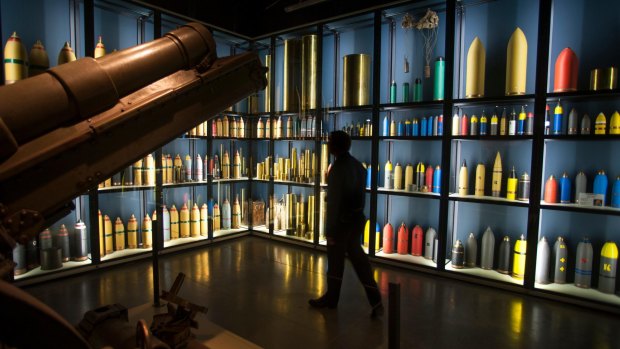
Shells from WWI on display at the Memorial Museum Passchendaele 1917 in Zonnebeke, Flanders, Belgium. Credit: Alamy
Souvenir hunting flourished, delivered as 1920s "trench art" – embossed ammunition shell cases, bayonets, bullet casings, shrapnel, helmets, hand grenades, certificates and photographs.
The French returned the Somme landscape to exactly as it had been before the war – every field, coppice, street, village, as if banishing the Germans and the war. German cemeteries were consolidated across Flanders and the Somme – we visit the sombre Langemark, where poison gas was first used. It's peaceful now with its grouped basalt-lava crosses and bronze "ghostly guardians" – the only place on the Western Front where the depiction of German soldiers is allowed.
Here lie 45,000 Germans, 25,000 in a mass grave and 5000 student soldiers' names engraved on oak inside the memorial. A striking anti-war memorial stands outside its gates.
For those wishing to forget, the scale of the war made it impossible then, and impossible now. Between 50 and100 bodies are recovered each year from the Western Front's fields and woods, more this year when about 100 German soldiers were found at Messines Ridge.
In 2009, 250 Australian and British soldiers were recovered from mass graves behind Pheasant Wood, buried by Germans after the disastrous battle of Fromelles in July 1916. Thousands of soldiers still lie undiscovered across the entire front, with more than 90,000 Empire soldiers in the Ypres Salient alone.
We arrive in Ypres the day after two Australian soldiers, unearthed with a British soldier, had lain in state under the Menin Gate. We visit their fresh graves in Tyne Cot, all three buried together as they lay for 75 years. Live munitions turn up weekly, placed beside roads for army disposal. Shrapnel, bullets, helmets still litter the fields, underground mines remain unexploded and farms still bear the ripple effect of underground tunnels, shell holes and trenches. It's unexpected, and confronting, just as the raw numbers of the dead are confronting.
You understand it rationally, but experience it emotionally in the sheer numbers of names on monuments, ranks of Jurassic limestone and marble headstones, crosses of sacrifice, German blockhouses crouching among fields of sugar beet, in woods and on hill crests and little cemeteries strewn across the Belgian and French countryside, "each with its own character" as Mat McLachlan points out in his guide to the Western Front's Australian battlefields, Walking with the Anzacs.
It's in the headstone inscriptions too, insights into grief and anger: "The bloody bastards did for him," reads one. And: "The white feather you gave him killed him." Most just offer Rudyard Kipling's simple words, "Known unto God".
The numbers astound. Pozieres and Mouquet Farm suffered 23,000 Australian casualties, 6800 deaths, in less than seven weeks, comparable with those during eight months at Gallipoli.
At Fromelles, Australians suffered 5533 casualties in one night, the worst 24 hours in Australia's military history, equivalent to total Australian casualties in the Korean, Vietnam and Boer wars.
Testament to this war's particular cruelty, a British general said after Fromelles, "I think the attack, although it failed, did ... a great deal of good".
The American Expeditionary Forces, in the final two days before Armistice forged on regardless, suffering more than 3500 casualties, despite knowing that fighting would end.
Menin Gate bears 54,389 names of men from Empire forces who fell in the Ypres Salient before August 16, 1917, and have no known grave.
Twelve thousand soldiers are buried at Tyne Cot, the world's largest Commonwealth war graves cemetery, 8000 unknown, 34,000 missing, inscribed on the cemetery walls.
About 40,000 Australians died or were wounded in 1916, a further 76,836 casualties in 1917 at battles such as Bullecourt, Messines and the four-month campaign around Ypres, known as Passchendaele.
In the steps of those pilgrims, we visit the Australian battlefields, the memorials to the missing and dead, the concentration and battlefield cemeteries, museums, woods, farms and villages, rehabilitated now, but all bearing the taint of that other world.
This comprehensive tour excels both in offering detail of how the Western Front evolved and honouring the personal narrative. Such an approach recognises the ongoing, universal impact of this "war to end all wars".
Our historian Pete Smith offers his encyclopaedic knowledge mercifully unsullied by clinical dispassion or its objectionable converse, triumphalism. His role as a former Royal Marine with family who have served in contemporary conflicts, adds another dimension – awareness of the social consequences of combat that yields a suicide rate 18 per cent higher than the general population.
He also knows the battlefields, living in Flers in north-west France, within sight of The Windmill Australian memorial at Pozieres. Australia's official war historian, Charles Bean, said: "The Windmill site ... marks a ridge more densely sown with Australian sacrifice than any other place on Earth."
During seven weeks in 1916 at the Battle of the Somme, there were massive casualties in the country around the Windmill. Soil from the site was scattered over the coffin of Australia's Unknown Soldier, recovered from Adelaide Cemetery, west of Villers-Brettonneux, which we visit, and interred at the Australian War Memorial in Canberra.
Like the master creator of a grand tapestry, Smith weaves the minutiae of human endeavour and loss on to the bald frame of war. Each person on our tour has their own story, which Battlefield Tours helps explore.
Some discover relatives' names at military cemeteries such as Tyne Cot, VC Corner, Hooge Crater or on Menin Gate where they lay wreaths. Some walk the land on which relatives served, to understand the complex texture of engagements. There are tears and reflection.
The many highlights include visits to The Memorial Museum Passchendaele 1917 in Zonnebeke and the Franco-Australian museum at Victoria School, Villers-Brettonneux. Another is being guided across battlefields such as Mont Saint-Quentin and Peronne, Fromelles, Le Hamel, Messines Ridge and Hill 60, and the Somme battlefield of the Newfoundland Memorial Park near Beaumont Hamel, with its preserved trench system.
Smith explains how the model for successful all-arms attack evolved. Tactics that initially yielded defeat finally produced victories such as Le Hamel. This battle, directed by Lieutenant General John Monash, secured the Somme capital of Amiens, demoralised the Germans and pointed the way to victory. Afterwards, King George V knighted Monash on the battlefield.
This writer finished the tour altered. For someone whose family suffered as many others had, my approach had been denial. This was how my father, grandfathers and stepfather addressed their wars – with silence.
My pilot father must have suffered the then unknown condition of PTSD, which helps explain his early death. My stepfather in the Polish and French resistance, tortured by the Nazis, refused to speak of it. My grandfather won a Military Cross on the Western Front – I never knew, finding it and documentation in a drawer after my aunt died.
I don't know why they stayed silent, but it wasn't their shame. It was the shame and failure of their world. In admitting that failure through understanding, we endeavour to avoid a recurrence.
One thing is clear – we must love those soldiers, but hate their wars.
TRIP NOTES
Alison Stewart was a guest of Mat McLachlan Battlefield Tours.
MORE
FLY
Vietnam Airlines flies daily from Sydney and Melbourne to Paris. See vietnamairlines.com
TOUR
Mat McLachlan Battlefield Tours operates a variety of tours from April to November. The four-day Western Front Explorer Tour is $1997 a person twin share. See battlefields.com.au
Sign up for the Traveller Deals newsletter
Get exclusive travel deals delivered straight to your inbox. Sign up now.